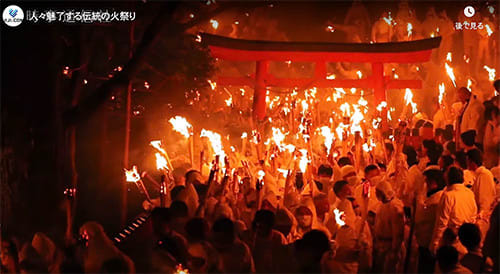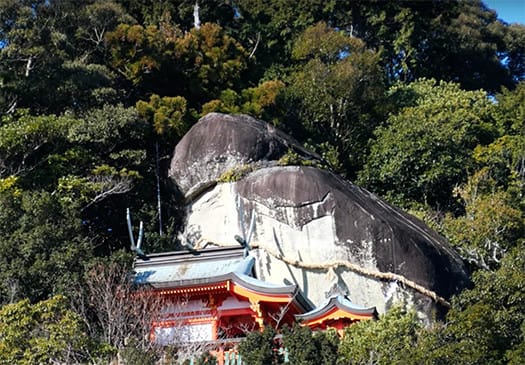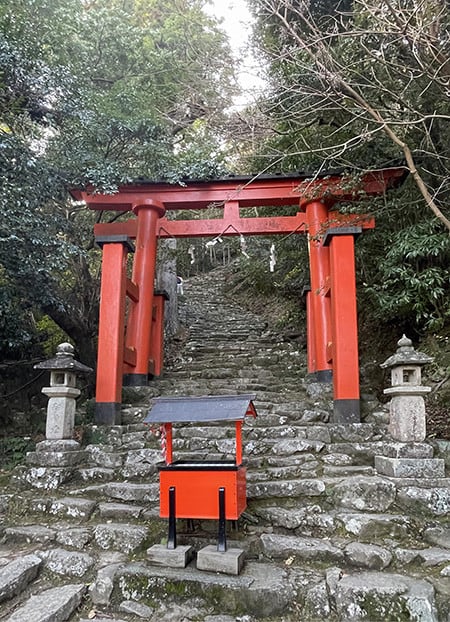


さて熊野三山の最後は熊野速玉大社なのですが、実際に熊野川河口の社には特段の感慨を持つことはなかった。ごく一般的な境内風景であり、特異性は感じられない。
しかし、事前に調査していてこの速玉大社の「摂社」神倉神社の存在を知っていた。一番上の写真は同社のHPからのもの。2枚目はわたしが撮影した参道の様子。かなり急坂の538段の石段を登らなければ到達できないことで有名な神社。熊野三所の大神が最初に降臨した場所とされており、平安時代以降には多くの修験者が集う場所にもなっていたようです。神武東征譚でも、この霊地に来られたとされている。
こういう修験スポットは日本人の自然崇拝と重なる「特異な」パワースポット性がある。
この印象的な岩石露頭に神聖性が強い印象でこころにストレートに迫ってくる。・・・ということでなんとか参道を上がろうと100段くらいは上ったのですが、訪問当日朝には楯ヶ崎でシカと遭遇するような自然道探査もしていて体力の消耗を招き、途中で断念せざるを得ませんでした(泣)。金比羅さんの785段では体力を温存していてしっかり登り切ったのですが、安土城とここには心理的に降参させられました(笑)。
っていうか、階段途中で早々に断念していた台湾からの観光のみなさん一団と、言葉が通じないのに話が盛り上がって、「これムリだよね」と国際親善交流していたのです(笑)。話せばわかる。

同社では「御燈祭〜火祭り」という神事が知られている。安部龍太郎の「半島をゆく」著作シリーズ・熊野編でその奇祭の存在を知った、まことに野性的な神事。和歌山県指定無形民俗文化財に指定される、世界遺産「紀伊山地の霊場と参詣道」の一部である神倉神社で毎年2月6日に行われる勇壮な火祭り。
白装束に荒縄を締めた約2000人の「上り子(のぼりこ)」と呼ばれる男子が御神火を移した松明を持ち、神倉山の山頂から、わたしが上るのを断念させられた538段の急峻な石段を駆け下るのだ。上るのもやっとのこの階段をたいまつを持って足下も見ずに駆け下るのだ、怖ろしい・・・。
県外者や観光客でも参加できるのが特徴だが、女人禁制なので女性は上り子としては参加できない。熊野神の来臨を再現し、家々に神の火を戴くという神事で、古くは祭礼で分けられた火が届くまで、各家で灯明を挙げるのを禁じていたことから、新年における「火の更新」を意味する祭りとして旧暦の正月6日に行われていたという。
この神倉神社の祭神は天照大神と高倉下命。高倉下(たかくらじ)は神武帝が熊野に上陸したときに鹿島神宮の祭神・タケミカズチからの神命を受けて神武帝に神剣を捧げて臣下になったと言う人物。
しかしどうもわたしには、この奇祭は花の窟神社の祭神でイザナミの産んだ「火の神」カグツチのことが想起される。きわめて始原的な火山列島地形での「カミ」のありようが示されていると思えてならない。
English version⬇
Kamikura Shrine and Gotobikiwa "Fire Festival" Shinto Ceremony Imperial Mythology and Kumano Journey-26]
This fire festival has been held since ancient times, evoking Kagutsuchi, the "god of fire" born of Izanami. It may be an expression of the simple religious beliefs of the people living in the volcanic archipelago. ...
Now, the last of the Kumano Sanzan is Kumano Hayatama-taisha, but I was not particularly moved by the actual shrine at the mouth of the Kumano River. It is a very common precinct scenery, and no peculiarity can be felt.
However, I knew of the existence of this "auxiliary" shrine of Hayatama-taisha, Kamikura Shrine, from my prior research. The top photo is from their website, and the second photo is a view I took of the approach to the shrine. The second photo shows the approach to the shrine, which is famous for its steep 538 stone steps that must be climbed to reach the shrine. It is said to be the place where the great deity of Kumano Sanjo first descended, and it was also a gathering place for many ascetic practitioners from the Heian period onward. It is said that even the tale of the Jimmu expedition to the east came to this sacred place.
These shugenja spots have a "peculiar" power spot nature that overlaps with the nature worship of the Japanese people.
This impressive rock outcropping gives a strong impression of the sacredness of the place, and it is straight to the heart. I tried to go up the approach to the temple and climbed about 100 steps, but on the morning of our visit, we had a nature trail exploration that led to an encounter with deer at Tategasaki, which exhausted my stamina and I had to give up halfway up the path (tears). I had saved my strength for the 785 steps of Kompira-san and made it to the top, but Azuchi Castle and this place made me give up psychologically (laugh).
I mean, I was having a friendly international exchange with a group of tourists from Taiwan who had given up on the stairway early, and even though we didn't speak the same language, we got into a lively conversation and said, "This is impossible" (laugh). If you talk, you will understand.
The company is known for its ritual called "Goto Matsuri - Fire Festival. This is a truly wild ritual that I learned of its existence from the Kumano section of Ryutaro Abe's "Peninsula on the Way" book series, and is a truly unique ritual. Designated as an Intangible Folk Cultural Asset by Wakayama Prefecture, this heroic fire festival is held every February 6 at Kamikura Shrine, which is part of the World Heritage Site "Sacred Sites and Pilgrimage Routes in the Kii Mountain Range.
About 2,000 men called noboriko, dressed in white and tied with a rope, carry torches carrying the sacred fire and run down the steep 538 stone steps from the top of the shrine to the top of Mt. It was scary to run down these steps, which I could barely climb, with the torch in my hand, without looking down at my feet.
The festival is open to visitors from outside of the prefecture and tourists, but women are not allowed to participate as climbers because women are prohibited. It is a Shinto ritual to reenact the coming of the Kumano God and to crown houses with divine fire. In the old days, it was forbidden to light a lamp in each house until the fire divided in the festival arrived, and the festival was held on the sixth day of the first lunar month as a festival signifying the "renewal of fire" in the New Year.
The deities of this shrine are Amaterasu and Takakura-shita no Mikoto. Takakuraji is said to have been a person who offered a sacred sword to Emperor Jinmu and became his vassal, receiving a divine command from Takemikazuchi, the deity of Kashima Shrine, when Emperor Jinmu landed in Kumano.
However, to me, this strange festival reminds me of Kagutsuchi, the "fire god" born of Izanami, who is the deity of the Hana-no-Kutsu Shrine. I can't help but think that this festival shows how the "kami" are in the very primitive topography of the volcanic archipelago.



















